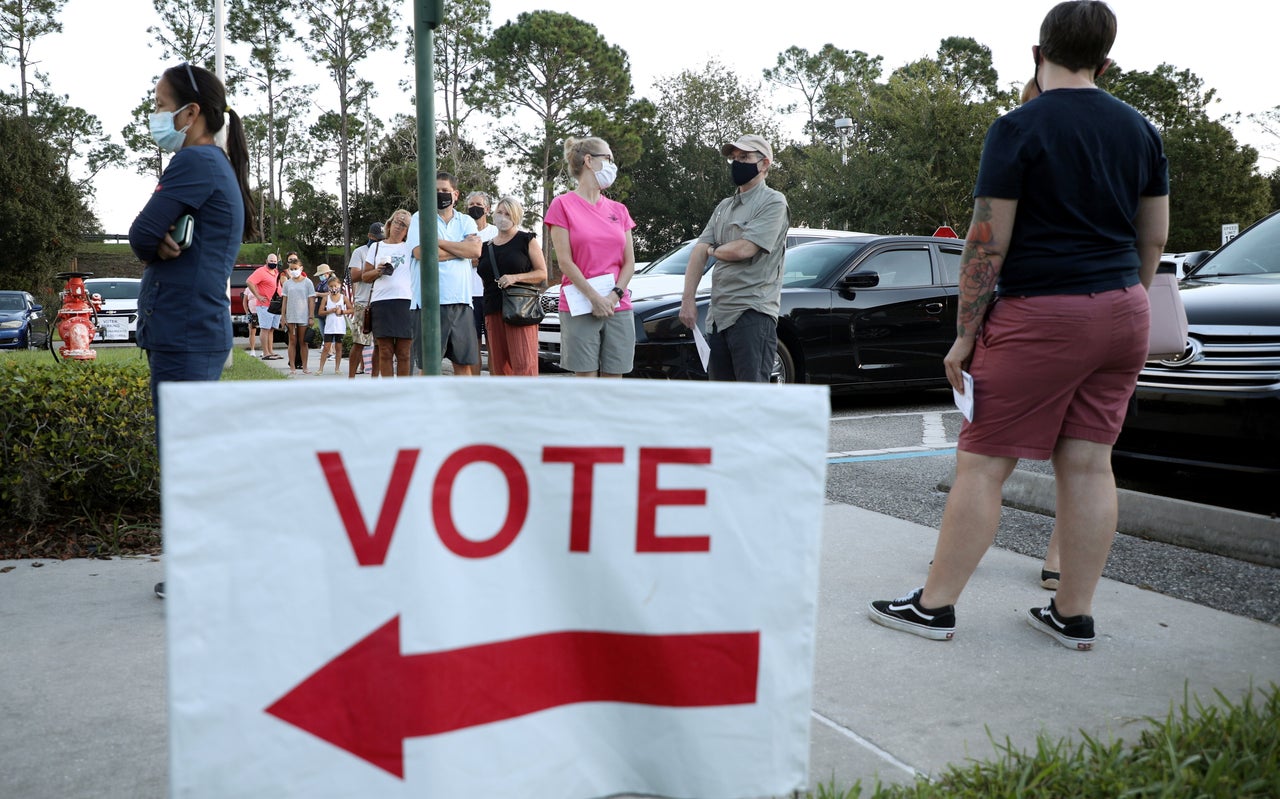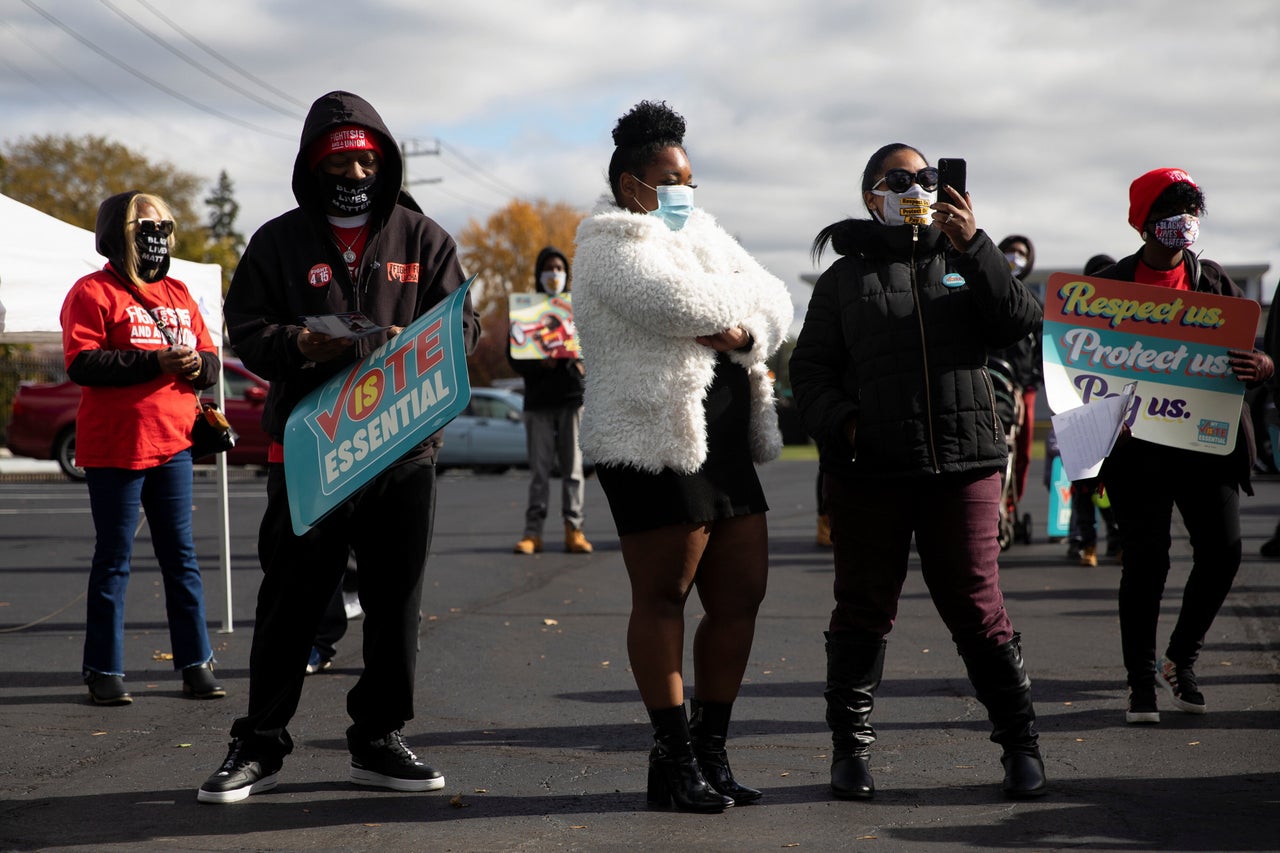Every four years, Americans gather in front of their TVs or computers to watch the results of the presidential election come in. Overcaffeinated cable news hosts zoom in and out of battleground state maps projected from towers of screens to fill time before any real news is reported. The polls close in state after state as the Western Hemisphere rotates away from the sun. Eventually, your preferred TV personality yells “Breaking news” and announces the projected winner of individual states.
Election night 2020, as everyone should know by now, will be different. And watching election results will be different, too.
The biggest reason: It is entirely possible that a winner will not be known on election night.
Stressful as it is ― and as much as President Donald Trump hates it ― that’s actually normal. Officially, the election results are never finalized on election night. When cable news hosts project that Trump won Alabama or that Democratic nominee Joe Biden won Massachusetts, for example, they do so based on unofficial results. Not a single state reports its final, official results on election night. Every state certifies its official results days after Election Day.
This happens every single election, but Trump has falsely claimed that it is illegal to count valid votes once the scheduled programming block called “election night” is over. It isn’t. Regardless of what Trump says, the final result and the winner of the presidential election will be decided when all of the validly cast votes are counted ― whether that takes hours, days or weeks.
This nonsense is particularly dangerous in the 2020 election because of how the coronavirus pandemic has altered voting. Far more people will cast mail-in and absentee ballots than in any previous election due to the pandemic. Some states will not be able to open, process or count those ballots until dawn on Election Day, or even until after the polls close. Results in some key swing states, including Michigan, Pennsylvania and Wisconsin, will not and cannot be projected by the end of Election Day.
But there are a handful of critical battleground states that do allow election officials to process and count mail-in ballots prior to Election Day. These ballots will be reported when the polls close. That leaves just in-person votes and ballots returned on Election Day to be counted. If these states are not too close, the winner could be called early. And if the right swing states are called early, it may be possible to project that Biden or Trump will have won the presidency.
Those are the key states to follow. Below is a guide on what to watch on election night, and how to know whether there will be a winner Tuesday night or early Wednesday, or whether you’ll have to stay glued to your screen for for days to come. (For simplicity, all times are EST.)
7 p.m.: Florida, Georgia

The first poll closures that will really matter are in Florida and Georgia at 7 p.m. Florida allows election officials to process and count absentee ballots prior to Election Day, while Georgia can process ballots before the election, but not count them until Election Day.
Both states provide a significant early in-person voting period. More than half of registered voters will have voted by Election Day in these states. This means the results in both states could be known on election night if they are not terribly close.
Florida is the most important state to watch if you hope to see an election winner called early on election night. It is the swing state with the largest number of electoral votes (29) most likely to complete its vote tally on election night.
Florida’s election results are typically very close, and polls show Biden with a narrow lead in this year’s race. The difference in the total number of votes cast for Democratic and Republican presidential candidates from 1992 through 2016 is less than 20,000 votes. In four elections, the winner won by less than 2 percentage points. The closest victory was George W. Bush’s win by 0.009 point in 2000. Bill Clinton claimed the biggest margin ― 6 points ― in 1996. Recent statewide elections have been no different, with the past three gubernatorial winners finishing with about a 1-point margin of victory. The 2018 Senate race was decided by a mere 0.13 percentage point.
Polling averages show the race in Florida is closer than in other swing states like Arizona, Michigan, North Carolina, Nevada, Pennsylvania and Wisconsin.

If news networks are able to project a winner in Florida, it could foreshadow how the rest of the election will play out. If Florida goes for Biden early, he is almost certain to be the next president. On the other hand, if Florida is called for Trump, or is too close to call, the election drama will drag into states less likely to complete their counts on election night.
So, what time can we hope to know? The press has projected a winner in Florida as early as 10:50 p.m. in 2016, when Trump won by 1.2 percentage points, and as late as 12:27 a.m. in 2004, when George W. Bush won by 5 percentage points. Barack Obama’s 2008 victory was called at 11:16 p.m. Results were delayed for four days in 2012, when Obama won the state again, but this time by less than 1 point. And, of course, there were the botched calls for both Al Gore and Bush in 2000 that led television news channels to reform how they project election winners.
Like Florida, Georgia is a state with a big electoral vote count ― 16 ― and if called for Biden would signal his impending victory. Since absentee ballots can be processed ahead of time in Georgia, something close to an unofficial vote result is possible on election night if the margin of the winner’s victory is above 1 percentage point.
Georgia has not featured a close presidential race since the 1990s. The state’s 2018 gubernatorial race between Republican Brian Kemp and Democrat Stacey Abrams was decided by less than 2 points. Kemp declared victory on election night, but Abrams did not admit defeat for nine more days as she sought a recount that could have pushed Kemp below the 50% threshold to avoid a runoff election. Presidential elections, however, are not subject to Georgia’s runoff rules.
7:30 p.m.: North Carolina, Ohio

North Carolina, like Florida, allows election officials to process and count absentee ballots ahead of time. This means that a winner could be projected on election night. With 15 electoral votes, it is a big Electoral College prize that, if won by Biden, will herald his victory.
In 2012 and 2016, the North Carolina winner was projected around 11 p.m. In both of those years, the winner won by 2 points to 3 points. When Obama won the state by 0.5 points in 2008, however, the result was not reported until two days after Election Day.
Ohio and its 18 electoral votes swung hard for Trump in 2016, when he won the state by 8 points. But 2020 polls there show the race is close, and most election ranking sites put it in the toss-up category. A Trump win in Ohio does not mean much, in terms of determining if he’s going to win or lose, but a Biden win would strongly signal that he will be the next president.
It’s helpful that Ohio election officials have been processing mailed ballots as they began arriving on Oct. 6. The ballots will be counted on Election Day. Ohio normally reports tabulated absentee ballots on election night soon after the polls close. Since there will be far more than usual this year, the reporting could be slowed, but not by as much as in other Rust Belt swing states.
8 p.m.: Pennsylvania

After falling into the Democratic Party column from 1992 through 2012, Pennsylvania voted for Trump in 2016 by a slim 43,000-vote margin. Biden only needs to win back the three “blue wall” states of Pennsylvania, Michigan and Wisconsin that had all gone for Democrats over the same period to claim victory. But there is little chance that Pennsylvania will report anything close to final results on election night.
Pennsylvania, which boasts 20 electoral votes, does not allow election officials to process or count absentee ballots in advance of Election Day. The Republican-led state legislature refused to adjust the rules for the pandemic. Most county election officials will begin processing and counting ballots at the beginning of Election Day, but some are not planning to do so until the polls close.
“[T]he overwhelming majority of ballots will be counted by the weekend, honestly, and maybe even significantly sooner,” Secretary of State Kathy Boockvar (D) said in September.
The one thing to pay attention to here is that results reported on Election Day will likely show an early Trump lead. Republicans report that they are far more likely to vote in-person on Election Day, while Democrats say they are more likely to vote by mail. This means Trump will jump to an early lead based on in-person ballots. This is being referred to as a “red mirage.”
The big swath of Biden votes are expected to create a “blue shift” as the mail-in ballots are counted. This may be so dramatic as to show a 15-point Trump lead on Tuesday night erased after mail-in ballots, which tilt to Biden by 21 points, are finally counted, according to FiveThirtyEight.
For that reason, don’t fret if there’s no Pennsylvania result called on Tuesday. All of this is totally normal, based on state laws for processing and counting mail-in ballots.

The Trump campaign, however, has indicated it will seek to stop Pennsylvania from counting ballots after Election Day. At least three conservative justices on the U.S. Supreme Court appear to be open to tossing ballots in Pennsylvania that are postmarked by Election Day but arrive up to three days afterward. Pennsylvania Attorney General Josh Shapiro (D) says that he is concerned that the Trump campaign would seek to suspend the counting of all absentee ballots while the court hears a challenge to these late-arriving ballots. If it comes down to Pennsylvania deciding the election, be prepared for a long winter.
9 p.m.: Arizona, Michigan, Texas, Wisconsin

The four major swing states fall into three buckets: Arizona and Texas will likely have close to full results on election night, as they can process and count mailed ballots before Election Day. Ballots can be processed in Michigan beginning the day before the election, which leaves some but not much time to count them before the end of election night. (Polls close in eastern Michigan at 8 p.m., while final polls in the western part of the state close at 9 p.m.) Wisconsin is not going to be able to report anything close to full results, as election clerks must wait until Election Day to process and count ballots.
Since Arizona and Texas are the most likely to report something close to full results on election night, these are the two states to watch in this poll closing block. Texas is the most likely of these two to reach something approaching a full total, as there will be far fewer mail-in ballots cast as a percentage of the total vote because the Republican-run state government refused to allow no-excuse absentee voting during the pandemic.
If Biden wins Texas and its 38 electoral votes, which no Democrat has done since Jimmy Carter in 1976, he will have won the election.

What may keep a winner from being projected in Arizona on election night is that the state normally sees a very high number of absentee ballots dropped off in-person on Election Day. In 2016, even though Trump won by 4 percentage points, the state’s results could not be called for two days as these ballots were counted. And in 2018, late-returned votes counted the day after the election fueled Sen. Kyrsten Sinema’s (D) win.
Michigan, with 16 electoral votes, and Wisconsin, with 10, will look a lot like Pennsylvania, with a large in-person Trump vote appearing on election night that will be whittled away by a large mail-in Biden vote. In Wisconsin, election workers plan to count ballots through the night and into the next day. Like Pennsylvania, do not expect results to be projected in either Michigan or Wisconsin on election night.
10 p.m.: Iowa, Nevada

Nevada and Iowa, with six electoral votes each, are the only two swing states with poll closings at 10 p.m. or later. The outcome in Nevada is more consequential for the presidential election than Iowa, which, if Biden were to win, would likely just be icing on the cake. Nevada, on the other hand, provided the final electoral votes putting Bush over the top at 11 a.m. on the day after the 2004 election.
Due to the pandemic, Nevada moved to conduct an all-mail election this year and mailed ballots to all active registered voters. Election officials are allowed to process and count ballots before Election Day. While this normally would mean there is a higher likelihood of the state reaching some kind of unofficial result with a projected winner on election night, Nevada also requires all ballots postmarked by Election Day to be counted. This means there could be a significant number of ballots outstanding that cannot be counted immediately.
Iowa allows officials to process ballots ahead of time, but not to count them. This should still speed up the reporting schedule on election night, but may not mean there is a projection.
At The End Of The Night
If Biden is winning on election night, you will be able to tell because a state like Florida is called either before midnight or in the early hours of Wednesday. There are few scenarios in which a Trump victory could be called on election night, but they rely on him winning the Upper Midwest states that won’t process and count absentee ballots until Election Day or the day before.
On the other hand, if the Sun Belt states that Trump won in 2016, like Arizona, Florida, Georgia and North Carolina, are called for him on election night, prepare to stay glued to the screen for the remainder of the week, month and year.
If the election comes down to which ballots will count in Michigan, Pennsylvania and Wisconsin, the election will be drawn out into a repeat of the 2000 Bush v. Gore debacle.
Just remember, the only thing that matters is who wins after all the votes are counted, whether Trump angrily tweets about it or not.
CORRECTION: An earlier version misstated the time North Carolina’s polls close. They close at 7:30 p.m.
We want to know what you’re hearing on the ground from the candidates. If you get any interesting ― or suspicious! ― campaign mailers, robocalls or hear anything else you think we should know about, email us at scoops@huffpost.com.